INTRO:
Occasionally, there are crossings of gameplay elements that at a glance, do not seem like they would ever be compatible with each other. Still, where this is will, there is a way; thus, titles like Yoku’s Island Express would join the list of games with bizarre mixtures of gameplay, alongside the likes of Herzog Zwei and Shouzou Kaga’s Fire Emblem.

PREMISE:
Yoku’s Island Express has a surreal setting. Initially, it begins with some familiar and well-worn tropes, like sapient animals with human-like homes, or at least abodes that would be in place in a Tolkien story. This island has a variety of climes, including a desert, a snowy mountain and a subterranean lake.
All is not well. However, before the player is introduced to the troubles on the island, the player is introduced to the player character – a dung beetle by the titular name of Yoku. Yoku has arrived at the island for its new job as the resident “postmaster”, who would in fact be the only functional employee around at the post office. Before the previous postmaster leaves for retirement, it warns the beetle that bad things are happening.
Indeed, even before arriving at the post office, the beetle is informed of a monster that has harmed the ancient creature that is keeping the island’s ecology in check. Those creatures are slowly dying from an esoteric infection in their wounds. For whatever reason, the other inhabitants are depending on the new postmaster to solve their problems, while also delivering long-overdue mail and packages.
That they are pinning their hopes on a dung beetle that has just arrived at the island might seem ludicrous. Even after the player has been informed of how the dung beetle can accomplish all that, the story still remains ridiculous, mainly due to the presence and use of magical paddles and bumpers.
THE DUNG BEETLE AND ITS BALL:
The beetle came with a smooth and (presumably) plastic ball. In fact, Yoku is tied to the ball. The reason for this is unclear, initially, but it is implied that Yoku has prepared itself for its new job. What exactly it is prepared for will be described later.
For now, its regular movement would be described. The beetle will always roll the ball about, and it will always be behind the ball, which is much larger than it. How it can see where it is going is a matter that is waved away. If the player switches direction, the beetle takes a second to change its position, but it will always do so regardless of the amount of space available.
The beetle itself has next to no inertia. The ball, however, does. If it is being moved through other means, it will drag the beetle along; it will be smacking into a lot of things too. As unpleasant as this would seem, the beetle does not suffer any permanent harm and recovers readily, even if it is dangling unconscious from the ball. The thread that ties it to the ball will also never break.
The ball itself also seems indestructible. Although there are some hazards that may seem dangerous, it and the beetle will never be irreversibly damaged.
PADDLES AND BUMPERS:
The gameplay elements of pinball make themselves known early. For some reason, there are paddles and bumpers in all kinds of places on the island, except underwater. Of course, the paddles and bumpers are used to launch ball-shaped things about, namely the beetle’s ball.
That these are used by the inhabitants of the island to move about only become evident later. They can either roll themselves up into balls, or they can magically morph themselves into balls. This also implies that the beetle had been informed about this method of transportation, and had prepared itself in a rather haphazard manner.
As for who is controlling the paddles in the narrative of the story, this matter is unclear. The player is controlling the paddles of course, but none of the characters addresses the player.
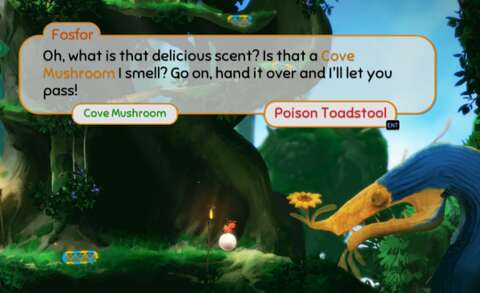
COLOURS FOR BUMPERS AND PADDLES:
The bumpers and paddles are colored cyan and yellow. The different colors correspond to the two control inputs for controlling them. In the case of bumpers that have both colors in their patterning, either control input triggers them.
There are no other visual differences in this attempt at differentiation, which can pose a problem for players that have this specific colour-blindness. There are no options to change the colors either. This is a notable gap in the design of the game.
For those who have particularly bad colour-blindness, they will have to resort to testing the paddles and bumpers to know which ones respond to which control input.
FRUITS:
In pinball, the player accumulates points for a score counter by having the pinball hit or touch things, usually colorful bumpers. The beetle’s ball will be hitting or touching things, but there are no points to be had. Rather, this yields bubbles with fruits suspended in them. (That these fruits include thorny pineapples is not an issue.) Having the ball come into contact with them releases the fruits, which immediately go into the beetle’s “fruit wallet”.
That said, fruits are apparently the primary currency on the island; incidentally, so many things yield them that eating them and using them like money is not a problem in this game’s fantastical economy. In fact, for some strange reason, gold coins in treasure hoards turn into fruits when they are looted.
This is a very bizarre game.
Anyway, being a newcomer, not every amenity on the island is available to the beetle from the get-go. Some bumpers are initially locked, and have to be enabled by paying a specific number of fruits. Fortunately, none of these locked bumpers are progress-gates; these bumpers are mainly there for the player’s convenience of moving around.
However, the beeline networks – which are very much like the cannon-barrels in Donkey Kong Country – are progress-gates. Incidentally, it costs a lot to unlock them, and only specific terminals allow the player to unlock specific branches in the network.
BRAMBLES:
In actual pinball, there are pits that are intended to receive any balls that the player could not hit with the paddles; these pits are called “drains” in this game, by the way. However, instead of a hole in the pit, there are brambles, which appear to grow all over the island. Falling through these is painful to the beetle, but otherwise does not inflict lasting injury and the ball is not damaged either. On the other hand, the beetle does lose some fruits. The beetle and the ball then either fall onto a bumper that can launch them back into the fray, or to a lower level of the “board” that they are currently in.
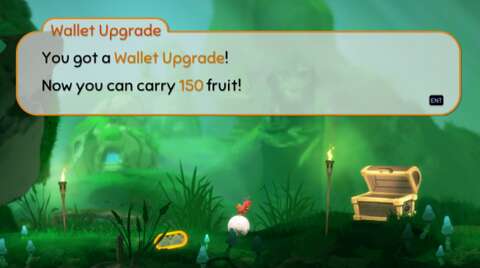
MAGICAL ROCKS:
The troubles on the island are causing some magical upheavals. Some of these upheavals are expressed as the appearance of magical rocks. These are not indestructible; they can be smashed by having the ball collide with them (and at any speed). However, they do not respond well to being struck; the ball rebounds from them at high speeds.
Some magical rocks are tougher than the rest, but these ultimately can be cracked through repeated hits. Indeed, these are there for the player to show off his/her pinball skills; they can be destroyed quickly by rapidly rebounding the ball with well-timed triggers of the paddles and bumpers. (Never mind that the beetle would be smacked about.)
TUBES/RAILS:
There are tubes or rails (it is unclear which is the case) that can quickly roll the bomb from one end to another. Either end automatically sucks in the ball if it is close, i.e. the ball does not have to be launched into any tube. However, since most tubes occur as part of challenges, launching the ball into tubes is usually the norm.
SEALS:
The troubles are also messing around with the magical seals on the island. Most of these act as barriers, thus acting as progress-gates. The seals can be opened fortunately. However, they take some effort, specifically the expression of one’s pinball skills.
Firstly, the player has to release the crystals of the seal, which can occur through one of two ways. One way has the ball flipping through a revolving flap that has the purple symbol of the seals. The flap becomes increasingly brighter as it is flipped; it loses brightness slowly over time, and loses more if the ball falls through brambles. After the flap has been completely lit, the flap releases the crystals that contain the power to unlock the seal. The other way is to smash the rocks that are holding the crystals within them.
Of course, the crystals have to be struck in order to destroy them, but they do not cause the ball to rebound. Indeed, if the player flicks the ball on the right path, it can hit multiple crystals. However, in most cases, the crystals are distributed across different paths, so the player has to flick the ball at different directions in order to unlock the seals. That said, unlocked seals remain so indefinitely.
CHECKPOINTS:
The player’s progress in a playthrough is recorded in only a single auto-save, which is updated whenever the ball passes by one of the brilliant flowers on the island. The flowers appear as closed pods initially, but open when the ball passes by them; they will always be vibrant, regardless of the climes that they are in and even underground when they are not receiving any sunlight.
INVENTORY:
Oddly enough, the beetle has a dimensional pocket somewhere on its person that can hold a lot of things, even though it needs a specialized wallet to contain the fruits. That said, the player would be coming across things both magical and mundane. Some of these are even living things, such as a creature that helps cover up pits so that the ball can be prevented from falling into the brambles.
Incidentally, the inventory would contain the things that contribute to this game’s Metrovania elements, including living creatures. For example, there is a juvenile “Dive Fish” that would stay in the beetle’s pocket until the beetle enters water, upon which it appears and latches onto the beetle’s abdomen, thus acting like a propeller and rudder. (The beetle can hold its breath for a long time, apparently.)
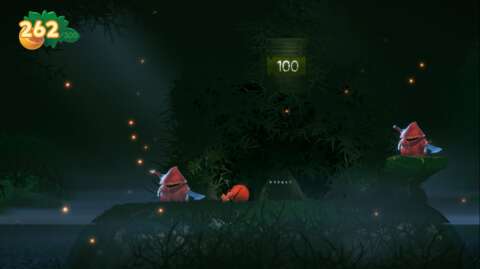
BUBBLES:
Some objects, especially the important pieces of loot or quest rewards, occur as floating objects that stay where they are until they are collected. However, for everything else, they occur as objects that are trapped in bubbles. All fruits, in particular, occur as items in bubbles. Bubbles have to be popped to release their contents. Fortunately, in return for the player’s trouble, the contents are immediately collected.
Bubbles that are already there in the game world will remain there until they burst. Bubbles that have been released by the ball’s collisions will float slowly upwards (which make them trickier to pop), and will eventually disappear.
METROVANIA ELEMENTS – OVERVIEW:
Speaking of Metrovania elements, some of these have been mentioned already, such as the Dive Fish. That said, these are made available via the devices that Yoku collects along the way.
PARTY HORN:
The first device is a party horn of sorts. The beetle can blow this at any time. (Yoku apparently has lungs for this purpose.) It can even blow the horn while it is being hurled about or being smacked into surfaces, if the player can spare a finger to mash away on the control input. Indeed, some collectibles are only obtainable in this manner.
The horn cannot actually harm things, but it can startle them into doing something – including something explosive, in the case of volatile things. The horn can also pop bubbles that are close to the beetle, which immediately collects anything that is released by the bubbles.
SLUG VACUUM:
One of the indigenous and non-sapient species on the island are explosive slugs. The slugs pop out of egg clusters, which release their inexhaustible contents whenever they are struck by the ball.
Slugs initially act as temporary obstacles, being in the path that the beetle and its ball must take in order to progress. Eventually, Yoku gains a vacuum device that allows it to suck in slugs when the ball goes near them when it is being hurled.
The requirement that the ball is being hurled is non-negotiable. There may be occasions where the beetle can just roll the ball into a slug, but the prompt to suck in the slug does not appear. That said, moving the ball into the slug counts as a collision that will detonate the slug.
DIVE FISH:
After falling into an underground lake, the beetle has no means of getting out – until it solves the problem that the denizens of the lake have. For Yoku’s efforts, he is rewarded with the companionship of a fish that enables underwater movement. Prior to this, the beetle – or rather the ball – will just float on water no matter what the player does.
Underwater segments are not subjected to any pinball physics and mechanisms. Incidentally, there are not many of these, and those there are happen to be there to have the player reaching places that were previously unreachable.

SOOTLING:
Upon the suggestion of an NPC, the beetle can pursue the capture and bondage of a Sootling; Sootlings are animals that are not seen in a good light in the story of this game, and are treated as cheap slaves by the more industrious denizens of the island. The Sootlings themselves are too dumb to mind much.
After obtaining a “Sootling”, the player can then use carnivorous flowers who prey on the Sootling species as if the flowers are rotary slings. Curiously, the player has complete control over these things, including when the flowers would catch the Sootling or release it.
TIME-SLOWS:
To aid the player in using the Metrovania tools, the game slows down whenever the conditions that allow their use are met. For example, when the ball is hurled close to a carnivorous flower, the flower somehow sucks the Sootling out of Yoku’s backpack. While the ball is within proximity of the flower, the player can enter the control input to let the flower swallow the Sootling. After the Sootling is caught in the flower, the application of the time-slow stops.
DIFFERENT SKILL-SET FOR SOOTLING USE:
Throughout much of the game, the player’s skill at pinball physics would be challenged. However, the use of the Sootling requires skill that is very much different from timing paddle and bumper strikes. Rather, when using the Sootling, the player needs to be aware of the tangential force that is acting on an object that is rotating around an axle. This force is the one that would launch the ball in the direction that the player desires.
Furthermore, getting the Sootling released at the right time is not so easy, because the ball would be rotating around the flower at considerable speed.
Indeed, there is one part of the game where the developers might have found the swinging action to be too much; they implemented a shortcut that makes use of pinball physics, and a checkpoint just before that shortcut.
WICKERLINGS:
“Wickerlings” are this game’s take on Mandrakes. They are tuberous plants with humanoid shapes, though they do not appear to be sapient or mobile, unlike other video game mandrakes. That said, Wickerlings are intended for one purpose, as their name suggests: they are fuel, specifically for magical torches. The torches incubate a certain creature that would be needed for the full epilogue of the story.
Understandably, Wickerlings are not easy to find. They are hidden throughout the island, with a few of them amusingly close to the torches that they would fuel.
Most would be half-buried in the ground, and can be popped out by tooting the horn near them. The bubbles that they are in can also be popped with the horn, if the ball cannot come into contact with them. These bubbles will never fade, by the way.
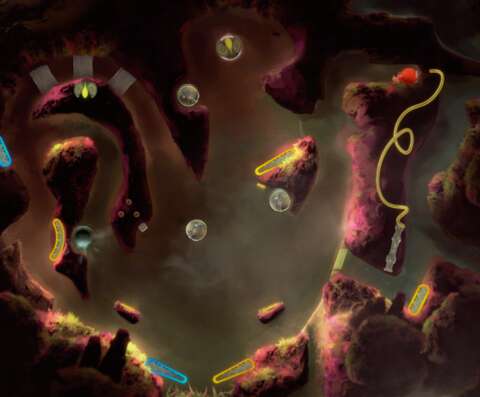
KICKBACK:
Kickback is a sidekick of sorts that is introduced early on. Kickback is immune to the brambles on the island, among other hazards. After rescuing it, it pledges its service to Yoku, though not entirely at the player’s beck and call.
Whenever the ball collides with things that release bubbles, one of the bubbles might contain Kickback, who presumably got out of Yoku’s backpack during the collision. Kickback then lies down on the brambles (or other hazards) in the pit, thus preventing the ball from falling through. However, Kickback is removed from the pit upon the ball striking it; the player might be able to have Kickback return in a bubble later, if the player is lucky.
SKVADER:
Most of the presentation of the game gives the impression that it is set in a tropical Caribbean island. The only indication that this game is made by Swedes is the “Skvader”. (The Skvader is a creature in Swedish folklore.) This is a creature that the beetle can stuff into the backpack, where it somehow makes eggs. Occasionally, one of these eggs is released when the beetle hits something that releases bubbles; the egg gets trapped in one of them.
Breaking the bubble provide the beetle’s ball with a buff that lets it release bubbles of its own. Somehow, these bubbles contain cut fruits. If the ball is moving, the bubbles are left behind like a trail; the player can have the ball retrace its path to collect them. Alternatively, the player can just wait for the ball to release bubbles all over the place.
VISUAL DESIGNS:
Yoku’s Island Express is a 2D game with vector graphics. The objects in the background, in particular, changes their perspectives as the player character moves about. Otherwise, almost everything in the foreground remains static as much as possible, discounting any animations that are important to gameplay.
The sprites for most characters are just vaguely humanoid; they are notably reminiscent of the creatures that are in Hayao Miyazaki’s more fantastical works. This is likely intended, considering the bizarre setting of the game. That said, not being exactly humanoid meant that the characters move about in whimsical ways.
Among the most notable examples is a native that has been infested with sapient hive-minded fungus. Its host slumps repeatedly, just before the parasitic fungus straightens it back.
The most animated character is of course Yoku itself. Its cheeks comically puff up when it blows the party horn (and other horns). Its body goes slack whenever it gets dragged and smacked around as the ball moves.
Other than these, the game depends on a lot of particle effects for its visual occurrences. The bubbles, in particular, have a lot of these when they are popped.
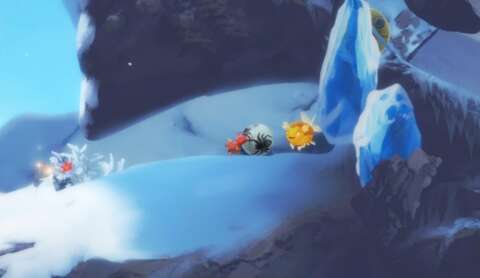
SOUND DESIGNS:
There are voice-overs, but they are illegible and have been strained through filters such that they sound utterly inhuman. The voice-overs do not match the current emotions of the characters either; they utter the same gibberish whether they are angry or happy.
The music is the best of the sound designs in this game. Although their composers do not have portfolios that are easily recognizable, what they have made is quite entertaining to listen to, especially the track that plays when Yoku has just arrived at the sandy beaches of the island.
As for the tracks themselves, they are a mix of illegible vocals and instruments, with some obvious synth. There are different tracks for different locales and different situations, most of which are thematically appropriate. For example, when the story transitions from the bright beaches to a rain-soaked forest, the music switches to a more somber track to highlight the troubles that are on the island.
In addition to these tracks, there are ambient noises, which are dependent on the locales that Yoku is in. For example, the Ivory Peaks are subjected to a lot of snow, so there is the howling of blizzard winds whenever the player character is there.
The collisions of the ball against the paddles and bumpers would not sound out of place in an actual pinball game, though this also means that they sound comically odd in a fantastical setting. As for the other sound effects, the player can expect a lot of tinkling and such other synth noises when the player triggers a burst of fruit bubbles or some other ludicrous occurrence.
SUMMARY:
This game fits well in Team 17’s repertoire of zany games, but there is the notable peculiarity that it was not done in-house. This is perhaps just as well, because Team 17 is looking to give others a chance at having their games known. Villa Gorilla and its debut project is a good decision on their part.
Yoku’s Island Express is a mostly competent hybrid of pinball and Metrovania. However, there are setbacks, such as the lack of color-blindness options for the bumpers and paddles. There is also the matter of the player needing to have particularly different hand-eye coordination skills for the use of the Sootling. The game is also quite short. Still, Yoku’s Island Express would not be a waste of time.

